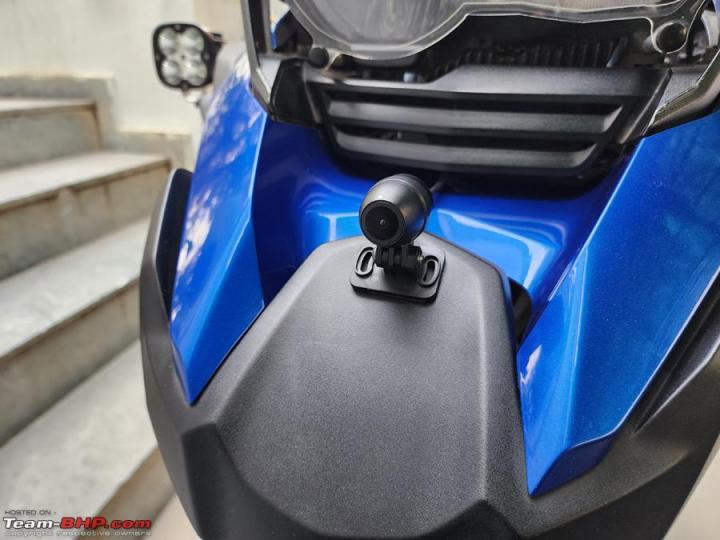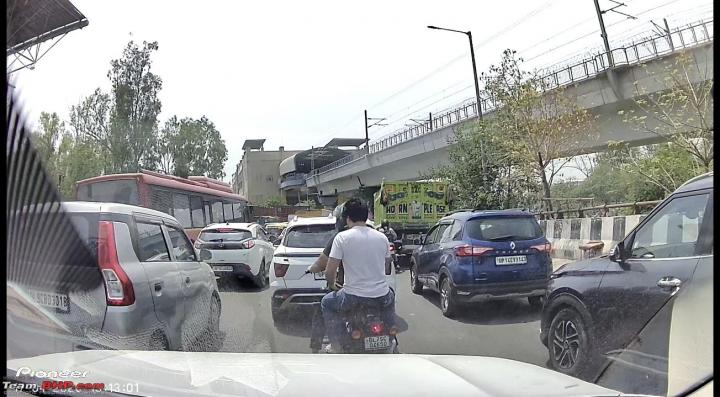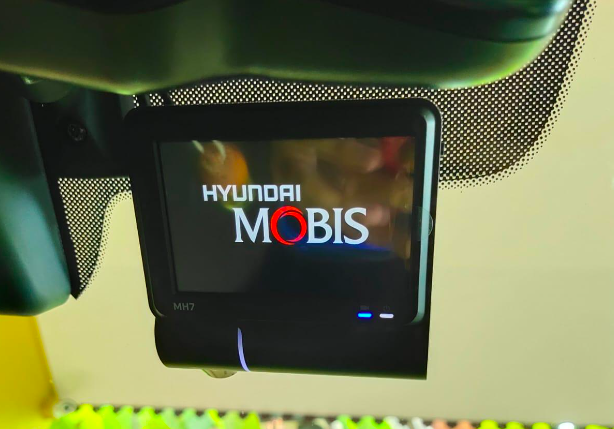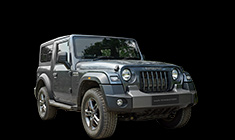News
Installing Aoocci C6 Pro all-in-one motorcycle dashcam on BMW R 1250 GS
Apart from being a dashcam, it also features Android Auto, GPS and anti-theft function.
BHPian dkaile recently shared this with other enthusiasts:
So the Navigator 6 was getting quite long in the tooth and out-dated, in this era of Android Auto devices. I had heard good things about this Aoocci (strange name) device and it was quite competently priced compared to the 50k they were asking for the Chigee, which was its nearest rival.
I purchased it directly from their website (no affiliations) with some online discount codes (around 30% IIRC), and the total landed cost to me was 14,595/- all inclusive. Very strangely, it was shipped by some warehouse in Delhi by DTDC and I received it in about 10 days' time and I had to pay no customs, etc. They must have very nice arrangements for India delivery at their backend.
This is how I received the packaging from DTDC -

A very nice Box inside -

Some specs on the side which are self-explanatory. It's supposed to be IP67 waterproof -

The Box contents - with Dual cameras, TPMS (which I did not install as my bike has it by default), all mounts and accessories -

Mounting Hardware for the handlebar was included separately -

A closer look at the device itself -

Fantastic fit and finish and aluminium alloy body -

A 64GB micro SD card was included for free for camera recordings -

Metal cover to install the card -

Made waterproof with proper rubber bungs for the ports. Also, notice a C-Type USB port to run it directly, when the device is off the bike -

The ports revealed below. All of very high quality -

Aluminium alloy back with integrated GPS -

Waterproof power box to connect to accessory power supply (switched). Multiple options were given to power up the device -

With an included inline 3A fuse -

A USB Type A power supply cord as an optional way to power it up. I presently use this method as I find it more convenient -

Solid Ball Joint to attach the device to the handlebar mount -

A size comparison with the BMW Navigator 6. Almost the same external dimensions with a much bigger display area -

Getting ready to remove the Nav Mount from the bike to fit the C6 Pro. These zip ties needed to be cut to free up the wiring -

GPS Mount power socket disconnected from the bike's OE wiring -

Getting ready to remove the screws so nothing falls in the crevices -

These nuts have a tendency to fall and never to be found again... lol -

Nav Mount removed in 5 minutes -

The full mounting displayed -

Both the Accessory power adapters were used including this Denali one -

The Nippy Norman one attached to the power box, which inline attaches to the Denali connector as shown earlier. I attached this but eventually used only the USB connector one -

Mounting completed on the handlebar mount -
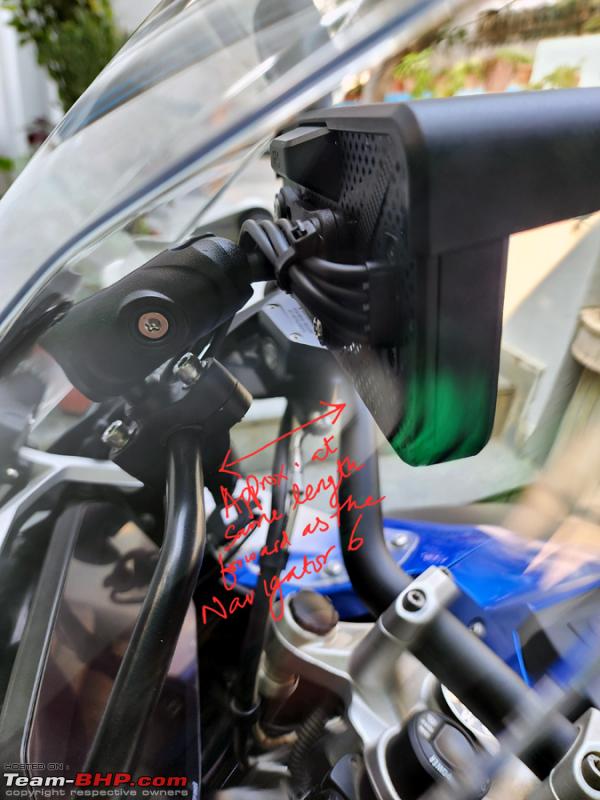
Everything was neatly zip tied not to be visible at all from the front -

The final result. No going back to Nav 6 ever -

Maps in full screen in Android Auto. Wireless connection -

Night View of the setup -

Continue reading dkaile's post for BHPian comments, insights and more information.
News
How I chased and caught a drunk van driver who crashed into my Creta
Everything was recorded on my car dashcam, and I can prove that the Maruti Eeco didn't stop, and it was a clear hit-and-run case.
BHPian naveen.raju recently shared this with other enthusiasts:
This happened on Sunday, and here’s the breakdown of the incident.
Watch the above video with audio to experience the impact.
I use my indicators quite a lot, and as seen in the video, I had my left indicator switched on. As soon as I switched to the right lane, I switched on the right indicator, ready to make the U-turn. This junction is pretty crowded and being a Sunday, it was relatively empty and you never see a speeding vehicle here, let alone on the right lane.
Out of nowhere, I experience a bang and apply the brakes on impact (The screeching sound you hear is from my car. The car moved from its original position even after applying the brakes. The impact was quite big). I immediately get out to examine the situation and that’s when the Eeco (which caused the accident) decides to make a run when I approach them. I thought someone would try and stop them or at least react, but the public was busy with their own things. I then take a Quick Look at my car and learn the damage wasn’t major, considering the level of impact. Since they made a run, I knew they were drunk.
The impact:
They could have easily taken any inner roads since this stretch had plenty but I decided to take the main road. These guys were nowhere to be seen and on top of that, I had a red light as well. My driving was nothing to write about and was rash/reckless. My speed slowed down a bit when I entered the bridge and I knew I had lost them.
Call it sheer luck, as soon as I drive down the bridge, I catch a glimpse of the Eeco taking a left turn (they might have thought this dark and a road with less traffic would easily be their ultimate escape route but they were wrong. I joined this road and clearly saw their vehicle. Didn't bother to honk and announce my arrival, instead just overtook them and stopped the car right in front of them. While overtaking, they knew it was me and tried to squeeze their way out. REGRET IN NOT BUYING A REAR DASHCAM!!! Would have captured all their antics.
The chase:
These guys were literally shocked when they saw me, and I asked them to step out of the vehicle. They were scared and didn't want to step. Since they knew things would escalate, they asked me to move the car to the side and would sort things out. I disagreed but on seeing this blocked the traffic, I decided to move the car.
Negotiations started and there were 4 drunk guys. The situation even though favorable to me, was not going anywhere. On questioning why they didn't stop, they argued that they had stopped the vehicle but on seeing me leave, they drove off. I stayed calm and said I have all recorded on the dash cam and I can prove that they didn't stop and it was a clear case of hit and run. Moreover, all 4 guys were drunk.
10-15 mins into the negotiation, a couple of guys came and went but one dude who passed by on a bike decided to watch the entire conversation. He then loses his patience and joins me when he learns that these guys were at fault. They call some random guy on the phone claiming to be a mechanic and say this is very minor and can be repaired for 2k. I disagree and say we can go to the station. Finally, since they were drunk, had bigger vehicle damage and their boss didn't know they were out of town (They were not from Cochin), they agreed to the amount I quoted. The entire episode took an hour, and I thanked the good Samaritan who stayed with me the entire time.
Now for the damages - mine just had a decent dent on the right side of the tailgate and a minor dink on the plastic bit of the bumper.


The Eeco had a pretty good hit.
- Driver side glass was shattered.
- Radiator was busted. It was leaking coolant.
- Considerable damage to the front.
- Had check engine light on.

Talked to the FNG and said it can be repaired with the amount I received. Will be taking it next and all developments will be updated in my ownership thread.
Check out BHPian comments for more insights and information.
News
BMW Drive Recorder as a dashcam? Real-world review with pros & cons
If I have a Bimmer with a built-in BDR (BMW 5 Series or higher), will I invest in another car dashcam?
BHPian Kelly66 recently shared this with other enthusiasts:
BMW Drive Recorder (BDR) Vs Redtiger 77 Dashcam:
Hello friends,
I came across a 1-month trial offer for the BMW Drive Recorder (BDR) in the MyBMW App and wanted to check it out and do a quick comparison with the Redtiger F77.
The Offer:

BMW Drive Recorder Write-up Claims the following, but the reality is slightly different (highlighted sections):
1) The system automatically records accident situations and automatically records data around your BMW, so you can see what actually happened. Alternatively, you can record magical memories of wonderful journeys at the press of a button.
- Visual documentation of accident situations
- Keep the memories of special journeys alive
- Enjoy the great feeling of being in the picture
2) The BMW Drive Recorder uses the exterior cameras of the driver assistance systems. In an accident, it automatically records up to 20 (30) seconds before and after the event. These videos contain all the vital information such as date, time, speed and GPS location.
3) Impressive scenery and lovely sunsets? Start recording manually via your BMW’s controller. You can save up to 40 (60) seconds of video in the car or straight onto another compatible medium.
4) Videos saved in your BMW can be transferred wirelessly to compatible media. So your memories are at hand whenever and wherever you wish.
BMW Drive Recorder Review
What I liked:
- Uses the 360 degree camera - you can choose to record all 4 cameras, 2 cameras or individual cameras
- Since cameras are outside, there is no reflection or glare - closer to the action and bonnet/boot don't come in the way.
- Colours are well saturated and natural looking and night footage is better than expected
- No wires, no connections - Software-based and well-integrated with iDrive
- Recordings can be viewed on the infotainment display when the vehicle is not moving
- When recording is activated manually, as you get close to an object (or when you reach an activation point), it captures the front/rear camera close-up view as a separate 6-10 sec video (see video clip)
- You can set BDR as a shortcut, and one press after opening the app will start recording
- Around 6 min of free storage is available in iDrive 8.5 (for testing waters), after that it will start overwriting old videos. Just for incident recording, this is more than enough or you can use a USB stick for storage expansion.
What I didn't:
- SXGA resolution @ 1280 x 960 resolution (1.3 MP, 4:3 aspect ratio) is above average (from a dashcam POV) when viewed standalone but the difference is more evident when compared alongside F77 at 4K (8 MP, 16:9) resolution - it's an unfair comparison though. (See video showing day and night samples after correcting the mirror image and changing the aspect ratio to 16:9)
- Frame rate is only 15 fps and the number plate is visible only at short distances and relatively darker at night (compared to F77). Dashcam footages need at least 25 fps for good number plate readability
- If you choose a camera view (All 4 or Front & Rear) to record, you can only view the recording in that view. For example, if you want to isolate and see a larger rear-only view in a 4-camera view recording, you can't.
- All 4 camera recording resolution < Front & Rear camera recording resolution < Single camera recording resolution. Front & Rear combo like a dual dashcam is a decent middle ground.
- Rear camera video footage is a mirror image - so what shows as left in the recording is actually right and number plates are also mirrored. This is a major flaw and I wonder how BMW can charge for this service without fixing this.
- Supports only H.264 encoding, takes 86 MB storage for 40 secs recording i.e. 129 MB per min (HD+/15 fps).
- Video length can only be 40 secs - okay for capturing incidents but not for travelogues
- There is no loop recording feature. Manually starting recording can be distracting. When I tried to start a recording near Garuda Mall, I forgot to turn on the right indicator and had a very close call with a scooterist. He could have scraped my car and even injured himself if he hadn't moved away in time.
- No Speed/GPS location in the videos
- No option for Wireless transfer of videos
Resolution and frame rate of BMW Drive Recorder

Resolution Chart & Aspect ratio

BDR view on iDrive 8.5 infotainment display
BDR Installed:

BDR Settings:


Manual start of recording:

View Recordings:

Memory full after 6 min of recording:

Video playback in 4:3 aspect ratio on a 16:9 display (real estate wasted)


BMW Drive Recorder Vs Redtiger F77 Dashcam Day & Night Video Comparison
In this video, you can see the following:
- BDR 4 Camera view - Narrow escape near Garuda mall
- BDR Front & Rear Camera view - Mirror image flaw
- BDR Vs F77 Video comparison (16:9) - Daytime Rear with correct mirror image
- BDR Vs F77 Video comparison (16:9) - Daytime Front
- BDR Vs F77 Video comparison (16:9) - Night Front
- BDR Vs F77 Video comparison (16:9) - Night Rear with correct mirror image
Conclusions:
- I availed the trial to just check how the BDR performs as a Dashcam. Even though the BDR has some Pros but the Cons outweigh them. However, I would encourage those who have this free trial option to give it a try and experience it.
- If I don't have a dashcam, will I buy the BMW Drive Recorder for my Bimmer? Not at all! I don't think it is worth spending so much for the functionality offered. There are many good dashcams in the market that can do a lot more for half the cost. In fact, even the high-end Redtiger F77 is cheaper and offers significant value for its price.
- If I have a Bimmer with a built-in BDR (5 Series or higher), will I invest in another dashcam? Perhaps not! I think I will manage with it and hope it saves me in an emergency.
- If you are a Travel enthusiast wanting to capture driving routes, BDR will not serve the purpose.
Thanks for reading.
Cheers!
Check out BHPian comments for more insights and information.
News
Bought a Pioneer dashcam from Amazon: Review after 9 hours of testing
To conclude, provided that it lasts for 2-3 years, Pioneer H120SC can be a much better option than budget Qubo and DDPAI models that offer similar specs.
BHPian self_driven recently shared this with other enthusiasts:
Had to leave on a work trip to Delhi and fixed the device temporarily as the car we were traveling in had no dash cam. It has been recording continuously at max resolution for more than 9 hours now without any errors.
Some observations:
1. Footage clarity is decent during day time. Numbers are readable in close range and slow moving traffic only. The clarity starts to become inconsistent at normal city speeds. I've attached some screenshots below. One of the image is captured at 40-50 km/hr, other two are at crawling speeds. At triple digit speeds, it does not capture a lot of details but the footage is good enough to steer clear of false accusations. I will be using it for rear view, so it serves my purpose.
2. Zenvue app has a very neat UI, easy to understand, no connectivity issues or bugs encountered so far. Recording resolution can be set to 1.5k, 1080p and 720p. There's no option to increase recording time interval from the default 60 seconds. File size is around 42 MB per clip at max resolution. Downloading clips is a breeze.
3. Heating is a concern. The device felt considerably hot to touch in just half an hour of operation even in early morning hours. That said, the higher-than-normal temperature remained consistent throughout the day. The drive included 4 hours of blazing sun as well, with the car's MID indicating ambient temperature of 37 degrees. Even though the device didn't skip a beat, I'm sure the lifespan will be compromised due to excessive heat.
4. Plastic quality and packaging is top notch. Everything feels classy, there are no cheesy words used anywhere on the product or the package. The camera has type C power input and is capacitor-based. The hinge mechanism looks good as of now, but I'm not too sure about its long term durability. Quality of 12v adapter is below average. There are no extra adhesive stickers in the package.
To conclude, provided that it lasts for 2-3 years, Pioneer H120SC can be a much better option than budget Qubo and DDPAI models that offer similar specs. Don't expect any miracles from it just because the package mentions a brand with great recall value. The app is good, design is cool, footage is decent, price is low and after all, as someone rightly pointed out, any dashcam is better than no dashcam.
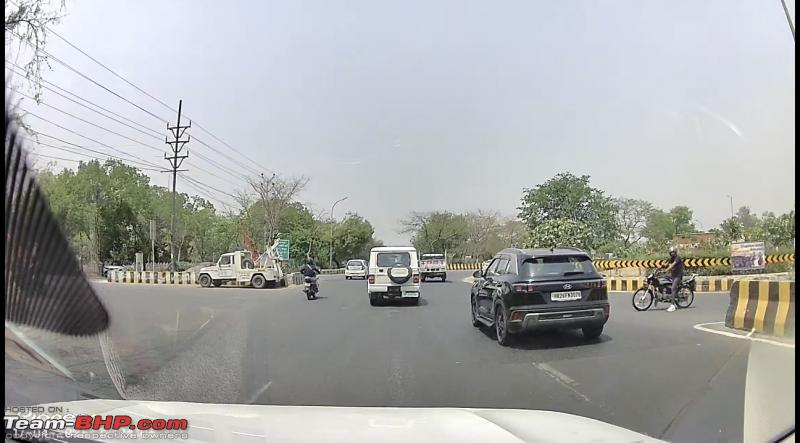


Read BHPian comments for more insights and information.
News
Enabling DVR Capture on my Mahindra Thar Roxx: No need of dashcam?
If you check the left portion under the glove box, you will find a small rectangular black cap portion at the far end which can be pulled open.
BHPian getsurya recently shared this with other enthusiasts:
Hi folks,
I have recently learnt that the Mahindra Thar Roxx AX7L has a DVR capture feature (akin to a car dashcam) and decided to explore that option.
I am sharing the same here for everyone's benefit. You will need to procure a 32 GB micro SD card to enable the feature.
If you check the left portion under the glove box, you will find a small rectangular black cap portion at the far end which can be pulled open. It will reveal two ports one of which is where the micro SD card can be inserted. Close the rubber cap once done.
On the head unit panel, press the 360-degree cam button to display the camera live options. Go to settings and you will see the DVR recording option, when you press that it will show you the recordings of all 4 cameras in the files storage area.
With this enabled, you actually don't need to invest in a dashcam additionally.
I am attaching some pictures for your reference.




Check out BHPian comments for more insights and information.
News
Installed Hyundai Mobis dashcam & other accessories on my Creta EV
Dealership did a very good job on the installation of the dashcam
BHPian Sandeep M recently shared this with other enthusiasts:
Recently added 2 accessories to my vehicle; Sports pedal cover and Hyundai Mobis dashcam with dual channel support and is hardwired into the car.
Total cost for dashcam is 14k, while the sports pedal cover costed me 2k.
Sporty pedal cover. (please ignore the dirty mat)
Hyundai Mobis MH7 dashcam. Dealership did a very good job on the installation. Quality is okay for daytime running, yet to do a night recording though. Also need to check if it's possible to install a CPL filter.


App for the dashcam. 
It's UI (Blanked out options due to not connected to the dashcam WiFi).
Options to download video.
Also bought a keycover from Keyzone. Really digging the looks. 
Check out BHPian comments for more insights and information.
News
My experience of using an old smartphone as a dashcam : Nokia XR 20
No additional expense. It can give a new purpose to an old smartphone lying at home. One may even consider it environmentally friendly.
BHPian r2212xx recently shared this with other enthusiasts:
I noticed that this thread has not been updated for several years now, so thought of sharing my experience of using an old smartphone as a dashcam.
Background
I was exploring dashcams for my car and, while doing so, got acquainted with several nuances. Notably, the dashcam would draw some trickle power when the vehicle is not in use. This is usually for the wake-up mode when the camera senses vibration and captures footage of a few seconds to a minute. While this is not a concern, the use case of my car was going to be about 80 to 100 km per month, with most drives on weekends. Considering the ultra-low usage, I was concerned that I might not be using the vehicle enough in a week to compensate for the trickle charge lost by the dashcam.
While ruminating about how to go about it, I considered exploring the possibility of using my old smartphone as a dashcam.
Using the phone
The phone I use is Nokia XR 20 attached to a standard phone stand that attaches to the dashboard through a suction cup.
The phone has an ultrawide 13MP camera with a 123-degree field of view (FOV).
You may choose any phone with at least 13MP ultrawide lens, which is considered to be a FOV of anywhere above 100 degrees. A camera with at least 114 to 115 degrees is preferable. There is no need for a specialised dashcam app, and the phone’s standard camera app is sufficient.
Note the following points as well.
- If the camera offers options between higher frame rate with lower resolution versus lower frame rate with higher resolution, pick the latter. A higher resolution makes it easier to zoom in and see vehicle numbers when reviewing the footage later.
- Ensure the phone has video stabilisation feature. This is vital otherwise all you will get is a shaky video. Some smartphones restrict video stabilisation to a lower resolution video, such as up to 1080p rather than 4K. While the higher resolution is preferred, it is of no use without video stabilisation. Therefore, in such scenarios, pick the resolution that works with image stabilisation.
- Use the video grid overlay lines, the ones that criss-cross the video, to align the video to the horizontal plane before you press record.
- Most smartphones limit the maximum video length to 30 minutes at a time. So, at some point during your trip, you may stop recording and then press the record button again. Traffic stops are usually the best time to do this.
Performance
Below is a GIF of a short section of a video. It is not very different from a dashcam footage.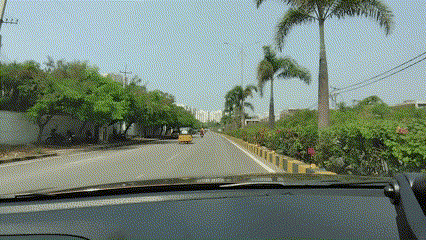
Before you begin
- Check what is the manufacturer-recommended operating temperature of the device. This is very important. Car dashboards can get very hot during summer. Some military-grade phones have tolerance to significantly higher temperatures.
- Some phones' wide-angle cameras are not great for low light or nighttime video recording. The acceptable quality level can vary as per the phone, so test it first. If the phone camera features a night mode, you may consider using it.
- Remove any unnecessary apps on the phone that may run in the background and drain the battery while also contributing to phone heating.
- Adjust the phone holder before the drive. Never make any adjustments while driving, as it can be distracting.
- Ensure you have enough phone or card memory available to record the videos for your trip.
For whom it is a great option
- Those who use their vehicle sparingly, such as weekend drives only or a few hundred or so kilometres a month.
- Those with more than one car, such as a second, smaller city car without a dashcam.
- Those who do short drives, such as max an hour of total drive a day.
- Those with several old smartphones lying around at home. The rate at which technology evolves these days, it is not uncommon for a phone's operating system to go obsolete, while the hardware per se stays fine.
Advantages
- Immediate review of footage: No need to connect through some app to the dashcam. Just review the footage on your phone’s screen.
- Easy cloud upload: In case you wish to retain the footage and want to keep a spare copy, you can easily back it up to the cloud using the phone’s Wi-Fi.
- No need for special memory cards: Smartphones support a wider range of memory cards than dashcams. Plus, if your phone’s internal memory is substantial, you do not need a memory card.
- Cost effective: No additional expense. It can give a new purpose to an old smartphone lying at home. One may even consider it environmentally friendly.
Limitations and Points to remember
- The phone dashcam best suits front-view recording. I would not recommend sticking a phone holder on the rear windshield or parcel shelf since the vehicle’s jerks may cause the phone to hit the windshield.
- Do not leave your phone in the holder in a parked car. Besides it getting heated up, it can be too conspicuous and tempting for thieves.
- Do not use the same phone for Android Auto or Apple Carplay (if the phone has a SIM card). It will heat up the phone faster and increase the chances of glitches.
- Keep a 12V charger and a cable handy just in case the phone needs charging. Alternatively, you may connect it to the charging-only USB port of your car. You can charge the phone while it is recording for short durations to prevent overheating.
Check out BHPian comments for more insights and information.
- Tags:
- Indian
- dashcam
- mobile mount
- cellphone
- DIY
News
Installed 70mai A510 dashcam along with CPL filter in my Hyundai Creta
The in-app experience is seamless. It doesn't hang, there is no lag, it is very user-friendly, connection to the dashcam is quick.
BHPian vattyboy recently shared this with other enthusiasts:
70mai A510 Dual Dashcam Set
So, purchased and installed 70mai A510 in my Creta
Box-

Front Dashcam-
The quality and in-hand feel is superb.
Looks premium and good after installation

Rear Camera-


Leave the video quality aside, talking about the in-app experience, which is seamless in 70mai (it doesn't hang, there is no lag, it is very user-friendly, connection to Dashcam is quick and videos are downloaded very quickly).

After using the Dashcam and observing the videos, I found out that there is a lot of Dashboard reflection and glare in the videos so I decided to buy the CPL filter.
Everyone who is using a Dashcam should add a CPL filter to their Dashcam as the difference is noticeable.
CPL Filter (Additional Cost - Rs 1000)



Installation of CPL Filter-
Very easy, just have to align the mark of the CPL filter on the Dashcam lens top center area and press it slowly.

- Video without CPL filter
- Video with CPL filter (notice the same angle and position of the sun in both videos)
Check out BHPian comments for more insights and information.
News
Installing LED headlight bulbs and a dashcam in my Maruti Brezza
Overall, the bulbs are brighter, whiter and mark an improvement for the low beam. But I feel that the HIDs on my Kia Seltos produce a better high beam.
BHPian ashis89 recently shared this with other enthusiasts:
I had been wanting to check the performance of LED bulbs for some time. Few months ago, when I got the headlamps of my Seltos replaced, I was tempted to remove the HIDs and install LEDs instead but decided to maintain status quo. The other guinea pig was the Brezza. LEDs could be tried on it.
After going through some posts, I ordered a pair of OSRAM 4200k HB3 bulbs from Planet Car Care for 4699 rupees (20 days later, the same product is listed at 5999!). While at it, also ordered a pair of OSRAM T10 LEDs for the parking lamps for 349 rupees.
Installing the parking lamps was straight forward and done in a few seconds. Turned on and one of them didn't work. By now I had learned that LEDs need polarity correction and so I flipped it and then it worked fine.

For the headlamps, I wasn't very sure. Seltos has a similar projector assembly with HB3 holder, but the bay is cramped and the access to the headlamps is very tight. Went through a couple of videos and realized Brezza bay has a lot more space. With some trial and error, I installed the first bulb. The light was bright and the cut off was similar to the other halogen. I had used the Allen key to align the holder adaptors so that the LEDs are aligned on the left and right within the housing. Then I worked on the right bulb and noticed it is loose with the stock rubber washer.
The OSRAM box comes with a couple of spare thick washers, an allen key for adjustment (learnt it the hard way later) and a couple of zip ties. I tried again after fitting one of those washers that was too thick and I couldn't. With no other option, I left it loose fit and installed the dust covers. With a short drive in the neighborhood, I figured there were a couple of dark spots. Overall, the bulbs were brighter, whiter and marked an improvement for the low beam. But the high beam still felt weak when I compared it to the HIDs on my Seltos. The throw and reach of the HIDs are far better than these LEDs.
Right is LED, left is stock halogen

Both are LEDs now



A day later, I went on a long trip. One evening, I got to use the lights and I noticed the beam pattern was inconsistent.





So once I was back home, I opened the bulbs again. The loose right one had almost come out of the holder and was all over the place. No wonder the beams were weird. So I adjusted the stock washer and that fixed the fit issue. Then I aligned the bulb again in the 3-9 position and fit it. Pattern against the wall looked slightly better than the other bulb. I thought of adjusting the left one again slightly. BIG MISTAKE!
LED pattern on wall

Stock halogen

I have sloppy hands. While refitting the bulb after readjustment, the adaptor ring fell off somewhere in the engine bay. It probably wasn't tightened well. Looked around for a long time in all possible corners but couldn't find it. Finally, I fit one of the halogens there and have placed an order for a HB3 adaptor, hoping that it will work with the OSRAM bulb.
Mismatched pair in use for now

I had also ordered a Qubo dashcam as the initial reviews on our forum had been good. The test video seemed decent and I won't lose my sleep for now.

Wire dangles slightly below the dashboard

Check out BHPian comments for more insights and information.
News
Things to keep in mind before picking a dashcam for your car
There are multiple benefits of installing a dash cam in your vehicle. Here are things you need to keep in mind before picking up the right dash cam
BHPian Kelly66 recently shared this with other enthusiasts:
Introduction
A Dashcam is a small addition to your vehicle that can bring many benefits:
• It's like an insurance for your car and for your family to protect you against road rage situations, catch mistakes of other drivers and proving your innocence against potential legal issues involving an incident on the road
• Dashcams can deter reckless driving and deter others from criminal activity
• Investing in one could potentially save you money not to mention peace of mind during those unexpected moments behind the wheel
• With a hardwire kit installed you could also capture hit and run incidents that happen when your car is parked
• An added bonus of having a dashcam is capturing pictures and videos for creating a travelogue
The Key Question: What video recording resolution and frame rate to choose when deciding on a dashcam? (this is based on my research from various articles on the Internet)
Actually, resolution and frame rate should be chosen based on your needs. The most common combinations you will find with dashcams are 4K(2160p)@30fps, 2.5K(1440p)@60fps and FHD(1080p)@30fps, but here's something to keep in mind:
• Higher the resolution, more the pixels, better the quality, BUT larger the video file size - On the F77, a 1 min video, based on HEVC (H.265) coding consumes 224MB at 4K/30 fps for Front and 174 MB at 4K/30 fps for Rear. H.264 coding will consume more space (see table below).
• Higher the frame rate, crisper the video, BUT again, a large video file size - On the F77, a 1 min video, based on HEVC (H.265) coding consumes 140 MB at 2.5K/60 fps for Front and the same 174 MB at 4K/30 fps for Rear (there is no 2.5K option for rear).
The real question is, for the file size, do you want more pixels or a crisper image? There are specific details you need to ask yourself before you jump in and choose your recording quality.
• 4K resolution offers better contrast and colour range, making it great for driving in city traffic with lots of cars and people around and is ideal for parking mode as well. You can zoom in without losing resolution, and it works better under lower-quality lighting.
• If there is a lot of motion in your video, you might benefit from choosing a higher frame rate over resolution. For example, if you often drive on highways, a higher frame rate is recommended because you can slow down the video to show the point of impact or details that the naked eye can’t see at full speed without compromising the crispness. However, high frame rates are not suited in low-light situations.
• If you do a lot of night driving, or if use parking mode, or if you prefer stunning visuals for your travelogues and social media uploads, go for 4K/30 fps preferably with a Starvis 2 sensor to capture number plates clearly at night. I am planning to use 4K/30 fps for city driving (~50%). On a 128 GB eMMC storage, usable storage is only 114.5 GB and I can get around 4.9 hours of recording for front and rear cameras put together, in this set-up.
• If you need to slow down frames without compromising the integrity, go with 2.5K/60 fps. I am planning to use this for highway driving, which is largely in daytime. I can get around 6.2 hours of recording for front and rear cameras put together, in this set-up.
Note: The size of a 4K video encoded in HEVC (H.265) is smaller than H.264, simply because HEVC codec saves nearly half by higher compression efficiency when compare to H.264, within the same graphic quality. That means we could benefit a whole lot from the compression. Redtiger F77 supports HEVC, hence the above file sizes are lower compared to the H.264 sizes shared in the table below.
H.264 recording space requirement:
Source:https://www2.yitechnology.com/suppor...3/qid/10/oid/_
Continue reading BHPian Kelly66's post for more insights and information.
- Tags:
- Indian
- dashcam
- car safety
Pages





